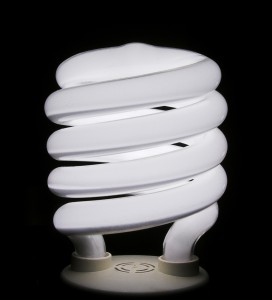
Every grocery store has them – those curly little compact fluorescent lights (CFLs) that claim energy efficiency. They claim to be up to 30 percent more efficient than the old round bulbs, and by 2020, the goal is for 70 percent more efficiency. Eventually, the traditional incandescent bulbs will be phased out and no longer available. They say it’s a way to reduce energy and therefore play a role in the reduction of greenhouse gas emissions, but what aren’t they spelling out to us about this fantastic new technology?
Within the CFLs there is a hidden and potent danger that most people are unaware of. They’re marketed “safe” and realistically don’t pose a threat – until the glass is cracked or broken. Although a miniscule amount of around 4 to 5 milligrams of mercury in contained in one single fluorescent light bulb, it is enough to contaminate and cause serious damage.
The chemical Mercury is a powerful, developmental neurotoxin that even in miniscule amounts can damage the brain, liver, kidneys and central nervous system if exposure is prolonged. At low levels, mercury can also impair motor function, cognitive ability and mental stability. Our infants and children are particularly vulnerable.
The EPA suggests the following when a CFL breaks.
- Have people and pets leave the room.
- Air out the room for 5-10 minutes by opening a window or door to the outdoor environment.
- Shut off the central forced air heating/air-conditioning system.
- Collect materials needed to clean up broken bulb: stiff paper; damp paper towels, etc; and a glass jar with a metal lid or a sealable plastic bag.
DO NOT VACUUM. Vacuuming is not recommended unless broken glass remains after all other cleanup steps have been taken. Vacuuming could spread mercury-containing powder or mercury vapor.
- Check with your local government about disposal requirements in your area. If there is no such requirement in your area, you can dispose of the materials with your household trash.
- If practical, continue to air out the room where the bulb was broken and leave the heating/air conditioning system shut off for several hours.
CFLs, according to GE, contain necessary amounts of mercury to allow the bulb to perform as an efficient light source, and that there are no direct threats to those who use them. As we now know from what history has taught us, mercury has an accumulative effect on the environment and those in it. It begs the question of another concern: what happens when the discarded bulbs with the mercury are dumped into local landfills?
Mercury aside, CFLs have also been under scrutiny for radiation emissions, causing electrical sensitivity with those who are vulnerable, and the increase of electromagnetic radiation emission.
This Article (Mercury Warning for CFLs) is free and open source. You have permission to republish this article under a Creative Commons license with attribution to the author and AnonHQ.com.






Great Article.
Yes it’s completely true. Fluorescent lamps are harmful, but also more harmful induction lamps. They create a greater magnetical field that harms humans worst that fluorescent lamps and they also have poisonous chemicals.
This is Alfredo Olivares Cardenas from http://www.rgbtronics.com.mx.